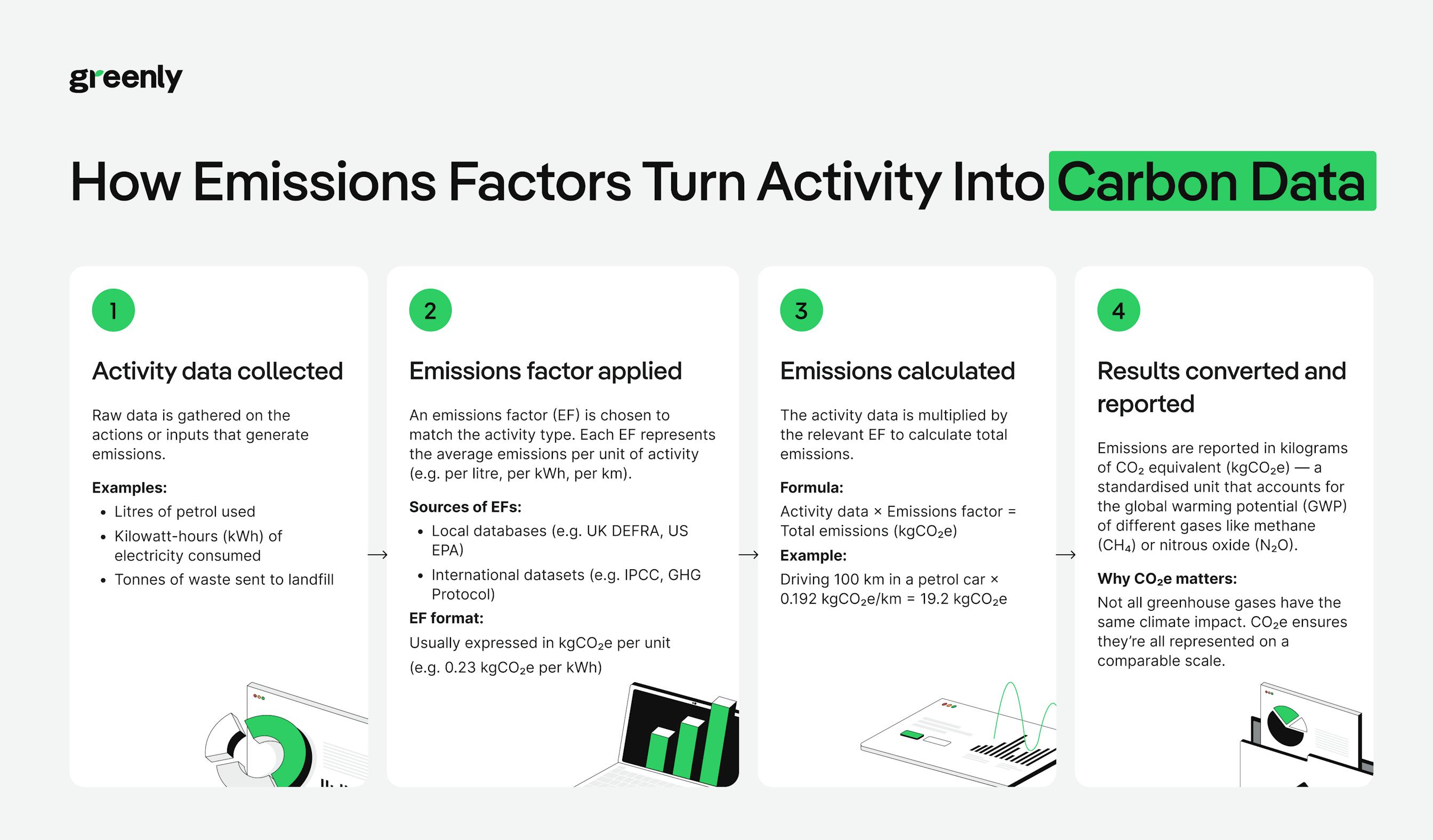
What are the 3 Pillars of Corporate Sustainability?
In this article, we'll explore what the 3 pillars of corporate responsibility are, why they're important, and how businesses can turn them into practical action.
ESG / CSR
Industries



Our comprehensive guide is here to help simplify and explain the significance of emissions factors, both local and international, in carbon accounting. We'll outline the important role they play in effective carbon management and showcase Greenly's commitment to blending ongoing research with a global outlook.
In this article, we'll explore why emissions factor databases, encompassing both local and international emissions factors, are crucial in accurate carbon footprint assessments.


The resulting emissions are usually expressed in kilograms of CO2 equivalent (kgCO2e), which accounts for the different global warming potentials (GWPs) of the gases involved. This ensures that emissions are consistently and accurately represented, no matter the source.
The role of EFs in carbon accounting is crucial. Each EF acts as a coefficient that allows businesses, governments, and organizations to quantify their carbon footprint – a crucial step in strategizing for carbon reduction. By understanding the emissions associated with different activities, entities can make informed decisions to reduce their environmental impact.
However, it's important to understand that EFs are not static. As our scientific understanding of emissions evolves and as technology advances, EFs must be routinely updated and published to reflect these changes. This dynamic nature of EFs is where ongoing research plays a pivotal role.
New research can lead to more accurate EFs or even entirely new factors for emerging technologies or processes. These factors are then applied to the corresponding activity data to ensure emissions are calculated accurately. This constant evolution in EFs is necessary to ensure that carbon accounting remains relevant and accurate, aligning with the latest scientific consensus and technological capabilities.
What makes an emissions factor database so useful is how it organizes data by activity and process. It encompasses a wide range of activities and processes, from industrial production, power plants and energy generation (which can vary widely depending on fuel type), transportation, to waste management, and more. Each category within the database has associated EFs, calculated and regularly updated to reflect the latest scientific research and environmental policies.
In some cases, particularly for product-level or Scope 3 emissions, these factors are informed by life cycle assessment (LCA) databases, which model the environmental impact of materials and products across their entire life cycle.
These databases are valuable for a number of reasons:
Accuracy
Helps calculate emissions precisely using EFs per unit of activity, such as per kWh or fuel volume - showing how many kg of CO₂e are emitted.
Decision-making
By understanding EFs by activity, businesses can identify high-emission areas and plan more sustainable practices.
Compliance
Supports accurate environmental reporting in line with local laws and international standards.
Benchmarking
Enables comparisons against average industry data or past performance to track progress over time.
Transparency
Backs clear reporting for investors and the public, especially when using IPCC-based methodologies.
When it comes to emissions factors (EFs), it's important to understand the distinction between local and international EFs.
Local EFs are specific to a particular geographic region or country. They are calculated based on local energy mixes, industrial processes, transportation methods, and environmental policies. For example, Norway’s electricity EF is low due to its heavy reliance on hydropower, unlike countries that depend on coal. This geographic variability in emissions sources highlights the importance of choosing factors that reflect regional realities where possible.
International EFs, on the other hand, are more generic and are applicable on a global scale. These are often derived from international research and databases, and may not account for the specific nuances of a particular region. However, they serve an important purpose in providing a standardized approach to emissions calculation, especially in cases where local data may not be available or is less comprehensive.
This raises the question: is it appropriate to use international EFs, particularly for global organisations like Greenly with a diverse client base? In many cases, it’s not only acceptable – it’s necessary. Here’s why:
Standardization and comparability
International EFs provide consistency for companies operating globally, making emissions calculations comparable across regions.
Best available data
In the absence of local EFs, international ones offer the most reliable alternative, ensuring no emissions go uncounted.
Broad coverage
These factors span a wide range of activities and sectors, supporting emissions estimates in any location.
Flexibility and adaptability
They reflect the latest research and trends, helping businesses keep pace with evolving global standards.
However, it's important to note that while international EFs are valuable, they should be used with consideration, and complemented by local EFs where available and relevant. Many EF databases, including Greenly’s, take this balanced approach to ensure both the accuracy and relevance of emissions calculations.
International emissions factors (EFs) - particularly those from the US, UK, and European countries - offer a mix of rigorous research and development, stringent regulations, and global applicability. The integration of these EFs into databases like Greenly's is essential for several reasons:
It's important to recognise that geography doesn't always significantly impact EF calculations. For example, Scope 1 emissions from burning a gallon of gasoline are consistent worldwide. However, geography can play a role in Scope 3 emissions, like those from the extraction, processing, and transport of gasoline, which can vary from region to region.
Even then, European EFs are often the better choice because they usually include both Scope 1, 2, and 3 emissions. In comparison, some US EPA factors exclude Scope 3, so the European data tends to offer a more complete picture.
This balanced approach towards EFs – acknowledging when geography matters and when it doesn't – enhances the accuracy and reliability of emissions reporting.
At Greenly, we offer more than just access to high-quality emissions factors – our one-stop sustainability suite helps businesses take control of their carbon footprint from start to finish, while supporting wider efforts to cut waste, resource use, and pollutants.
Our platform includes:
Whether you're just getting started or looking to refine your sustainability strategy, Greenly provides the tools and insights to help you remove uncertainty when it comes to your carbon footprint – and build a stronger connection between data, action, and results. Get in touch with us today for additional information.
